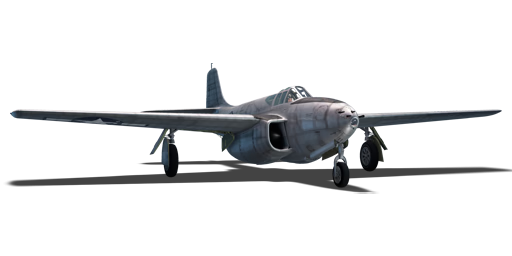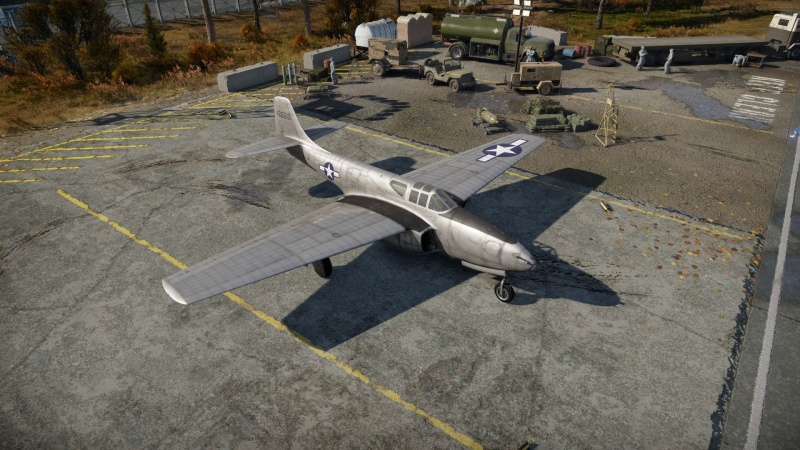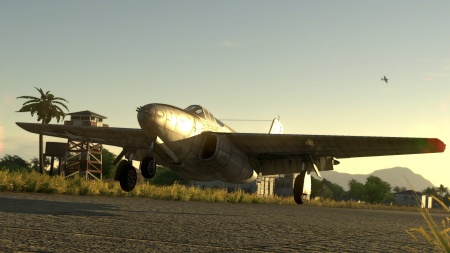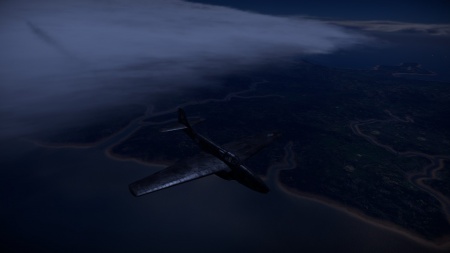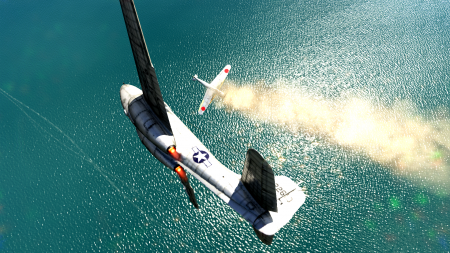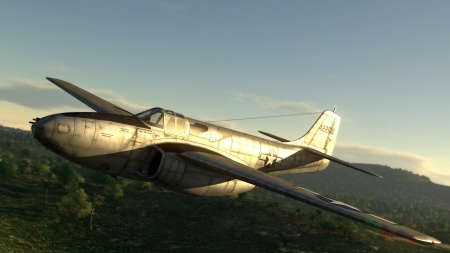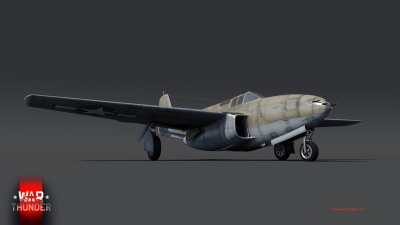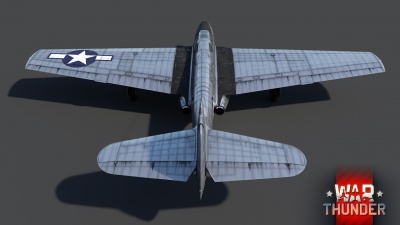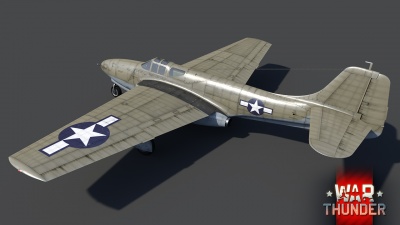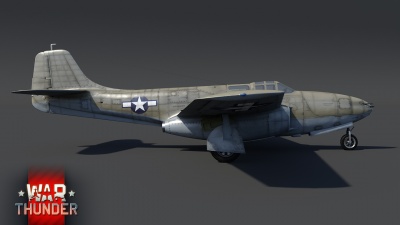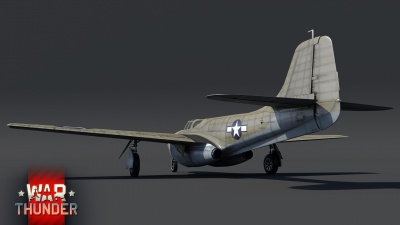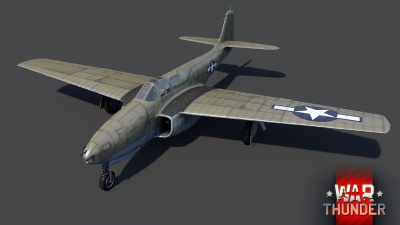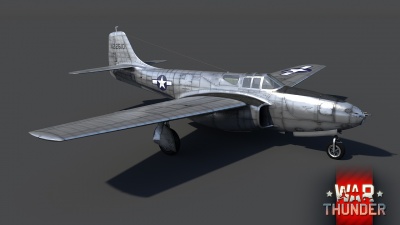Difference between revisions of "P-59A"
m (→Details: Updated template to preferred type) |
Colok76286 (talk | contribs) (Undo revision 193133 by U112260934 (talk)) |
||
| (15 intermediate revisions by 9 users not shown) | |||
| Line 1: | Line 1: | ||
{{Specs-Card | {{Specs-Card | ||
|code=p-59a | |code=p-59a | ||
| + | |images={{Specs-Card-Image|GarageImage_{{PAGENAME}}.jpg}} | ||
|market=P-59A (USA) | |market=P-59A (USA) | ||
| − | }} | + | }} |
== Description == | == Description == | ||
| − | <!--In the description, the first part should be about the history of and the creation and combat usage of the aircraft, as well as its key features. In the second part, tell the reader about the aircraft in the game. Insert a screenshot of the vehicle, so that if the novice player does not remember the vehicle by name, he will immediately understand what kind of vehicle the article is talking about.--> | + | <!-- ''In the description, the first part should be about the history of and the creation and combat usage of the aircraft, as well as its key features. In the second part, tell the reader about the aircraft in the game. Insert a screenshot of the vehicle, so that if the novice player does not remember the vehicle by name, he will immediately understand what kind of vehicle the article is talking about.'' --> |
| − | + | At the early stages of World War II in 1941, Major General Henry H. "Hap" Arnold was invited to attend a demonstration of the United Kingdom's Gloster E.28/39, the first British jet aircraft. Impressed with what he saw, he requested a copy of the blueprints to the Power Jets W.1 turbojet engine and received them along with a Whittle W.1X turbojet and drawings for the more powerful W.2B/23 engine. All of this was handed over to General Electric for them to produce a U.S. version of the engine. Next, Bell Aircraft Corporation was approached to build a fighter which would utilize this new jet. Accepting the challenge, Bell started by modifying a version of its P-63 Kingcobra propeller-powered fighter. | |
| − | |||
| − | |||
| − | + | To accommodate the new type of engines, the {{PAGENAME}} underwent some significant modifications such as a higher placed wing (mid-fuselage compared to the P-63's low-wing setup), extended tail and fuselage and widened body to accept the turbojet engines. The new {{PAGENAME}} was plagued with many problems (many of which were attributed to early turbojets themselves), though, in the fighter was tested by pilot Chuck Yeager who was thoroughly dissatisfied with the speed of the aircraft, however, he noted that the flight characteristics of the aircraft were amazingly smooth. | |
| − | + | Introduced during [[Update 1.89 "Imperial Navy"]] as a reward for the [[wt:en/news/6293/current|2019 Operation H.E.A.T event]], the {{PAGENAME}} finds itself in a unique position as a jet fighter sitting at rank IV, though just having turbojets compared to opponents at its battle rating sporting propellers will not give it the sole advantage. Several turbo-props will be able to keep up; however, the manoeuvrability of this aircraft is where it shines and when the pilot utilizes rudder control and combat flaps, the {{PAGENAME}} can surprisingly outmanoeuvre many aircraft including British Spitfires. The 37 mm autocannon and the three 12.7 mm machine guns are sufficient enough to punch large holes through enemy aircraft or dismantle them piece-by-piece. Without any suspended ordnance, the {{PAGENAME}} will strictly be a fighter/bomber interceptor unless there is a corner of the map where the Airacomet can ground attack without the threat of ambush by enemy fighters as it will need to maintain its speed to be useful. | |
| − | |||
| − | |||
== General info == | == General info == | ||
=== Flight performance === | === Flight performance === | ||
| − | <!-- Describe how the aircraft behaves in the air. Speed, manoeuvrability, acceleration and allowable loads - these are the most important characteristics of the vehicle. --> | + | {{Specs-Avia-Flight}} |
| + | <!-- ''Describe how the aircraft behaves in the air. Speed, manoeuvrability, acceleration and allowable loads - these are the most important characteristics of the vehicle.'' --> | ||
[[File:P-59A *kamikazi-kit 001.jpg|450px|thumb|right|Without having to worry about propeller clearance, the '''{{PAGENAME}}''' had stubby landing gear.]] | [[File:P-59A *kamikazi-kit 001.jpg|450px|thumb|right|Without having to worry about propeller clearance, the '''{{PAGENAME}}''' had stubby landing gear.]] | ||
| − | The P-59A ''Airacomet'' is quite an unusual jet with a number of unique and quirky characteristics. Firstly, it has a very low battle rating considering it is a jet. The reason for this is due to how poor its performance is compared to every other jet and most super-props (P-51H, F8F-1B, Bf 109 K-4, G.56, I-225). Secondly, the aircraft is unbelievably manoeuvrable and able to out-turn Spitfires at the BR with the correct usage of the combat flaps and rudder. These oddities make the ''Airacomet'' a very interesting plane to fly and the complete opposite of 90% of jets the player might've flown before. The P-59 has excellent manoeuvrability and decent roll rate. The very terrible acceleration is something to keep an eye on, but in a straight line, you will be able to catch other opponents. It will take a long time to get up to speed, but sooner or later, you'll catch your opponent if they continue to fly in a straight line. | + | The P-59A ''Airacomet'' is quite an unusual jet with a number of unique and quirky characteristics. Firstly, it has a very low battle rating considering it is a jet. The reason for this is due to how poor its performance is compared to every other jet and most super-props (P-51H, F8F-1B, Bf 109 K-4, G.56, I-225). Secondly, the aircraft is unbelievably manoeuvrable and able to out-turn Spitfires at the BR with the correct usage of the combat flaps and rudder. These oddities make the ''Airacomet'' a very interesting plane to fly and the complete opposite of 90% of jets the player might've flown before. The P-59 has excellent manoeuvrability and decent roll rate. The very terrible acceleration is something to keep an eye on, but in a straight line, you will be able to catch other opponents. It will take a long time to get up to speed, but sooner or later, you'll catch your opponent if they continue to fly in a straight line. |
| − | {| class="wikitable" style="text-align:center" | + | {| class="wikitable" style="text-align:center" width="70%" |
! rowspan="2" | Characteristics | ! rowspan="2" | Characteristics | ||
! colspan="2" | Max Speed<br>(km/h at 9,144 m) | ! colspan="2" | Max Speed<br>(km/h at 9,144 m) | ||
| Line 41: | Line 39: | ||
==== Details ==== | ==== Details ==== | ||
| − | {| class="wikitable" style="text-align:center" | + | {| class="wikitable" style="text-align:center" width="50%" |
|- | |- | ||
! colspan="6" | Features | ! colspan="6" | Features | ||
| Line 47: | Line 45: | ||
! Combat flaps !! Take-off flaps !! Landing flaps !! Air brakes !! Arrestor gear !! Drogue chute | ! Combat flaps !! Take-off flaps !! Landing flaps !! Air brakes !! Arrestor gear !! Drogue chute | ||
|- | |- | ||
| − | | ✓ || ✓ || ✓ || | + | | ✓ || ✓ || ✓ || X || X || X <!-- ✓ --> |
|- | |- | ||
|} | |} | ||
| − | {| class="wikitable" style="text-align:center" | + | {| class="wikitable" style="text-align:center" width="50%" |
|- | |- | ||
! colspan="7" | Limits | ! colspan="7" | Limits | ||
| Line 62: | Line 60: | ||
! Combat !! Take-off !! Landing !! + !! - | ! Combat !! Take-off !! Landing !! + !! - | ||
|- | |- | ||
| − | | {{Specs|destruction|body}} || {{Specs|destruction|gear}} || | + | | {{Specs|destruction|body}} || {{Specs|destruction|gear}} || 495 || 460 || 290 || ~10 || ~6 |
|- | |- | ||
|} | |} | ||
| Line 89: | Line 87: | ||
|- | |- | ||
! colspan="3" | Engine characteristics | ! colspan="3" | Engine characteristics | ||
| − | ! colspan="3" | Mass with fuel (no weapons load) || rowspan="2" | Max Takeoff<br/>Weight | + | ! colspan="3" | Mass with fuel (no weapons load) || rowspan="2" | Max Takeoff<br />Weight |
|- | |- | ||
! Weight (each) || colspan="2" | Type | ! Weight (each) || colspan="2" | Type | ||
| Line 98: | Line 96: | ||
|- | |- | ||
! colspan="3" | {{Annotation|Maximum engine thrust @ 0 m (RB / SB)|The maximum thrust produced by each engine, while mounted in the aircraft. NOTE: Thrust varies significantly depending on speed & altitude.}} | ! colspan="3" | {{Annotation|Maximum engine thrust @ 0 m (RB / SB)|The maximum thrust produced by each engine, while mounted in the aircraft. NOTE: Thrust varies significantly depending on speed & altitude.}} | ||
| − | ! colspan="4" | Thrust to weight ratio @ 0 m ( | + | ! colspan="4" | Thrust to weight ratio @ 0 m (105%) |
|- | |- | ||
| − | ! Condition || 100% || | + | ! Condition || 100% || 105% |
! 8m fuel || 20m fuel || 29m fuel || MTOW | ! 8m fuel || 20m fuel || 29m fuel || MTOW | ||
|- | |- | ||
| Line 106: | Line 104: | ||
| 0.39 || 0.36 || 0.34 || 0.27 | | 0.39 || 0.36 || 0.34 || 0.27 | ||
|- | |- | ||
| − | | ''Optimal'' || 750 kgf<br/>(0 km/h) || 780 kgf<br | + | | ''Optimal'' || 750 kgf<br />(0 km/h) || 780 kgf<br>(0 km/h) |
| 0.39 || 0.36 || 0.34 || 0.27 | | 0.39 || 0.36 || 0.34 || 0.27 | ||
|- | |- | ||
| Line 112: | Line 110: | ||
=== Survivability and armour === | === Survivability and armour === | ||
| − | <!-- Examine the survivability of the aircraft. Note how vulnerable the structure is and how secure the pilot is, whether the fuel tanks are armoured, etc. Describe the armour, if there is any, and also mention the vulnerability of other critical aircraft systems. --> | + | {{Specs-Avia-Armour}} |
| + | <!-- ''Examine the survivability of the aircraft. Note how vulnerable the structure is and how secure the pilot is, whether the fuel tanks are armoured, etc. Describe the armour, if there is any, and also mention the vulnerability of other critical aircraft systems.'' --> | ||
* 6.35 mm steel plate mounted behind the armaments | * 6.35 mm steel plate mounted behind the armaments | ||
| Line 120: | Line 119: | ||
* 9.5 mm steel plate mounted behind the pilot's head | * 9.5 mm steel plate mounted behind the pilot's head | ||
| − | As an early jet fighter, common carryovers from the propeller-driven aircraft were found in the {{PAGENAME}} which were eliminated in later aircraft in favour of more fuel or heavier suspended armaments. It was standard to envelop the pilot with armoured plates especially in a fighter such as the Airacomet to protect from defensive fire or anti-aircraft shrapnel. To protect the pilot from attacks from the front, a 6.35 mm steel plate was placed both behind the offensive weapons and in front of the instrument panel in the cockpit. A 38 mm bulletproof glass was installed in the front windshield. Three different armoured plates were placed behind the pilot's seat and headrest and were of varying thicknesses of 6.35 mm and 9.5 mm. | + | As an early jet fighter, common carryovers from the propeller-driven aircraft were found in the {{PAGENAME}} which were eliminated in later aircraft in favour of more fuel or heavier suspended armaments. It was standard to envelop the pilot with armoured plates especially in a fighter such as the Airacomet to protect from defensive fire or anti-aircraft shrapnel. To protect the pilot from attacks from the front, a 6.35 mm steel plate was placed both behind the offensive weapons and in front of the instrument panel in the cockpit. A 38 mm bulletproof glass was installed in the front windshield. Three different armoured plates were placed behind the pilot's seat and headrest and were of varying thicknesses of 6.35 mm and 9.5 mm. |
| − | As the {{PAGENAME}} struggles for speed, it may have been a better option to sacrifice all of the armour but the bulletproof windshield in order to allow for the extra speed due to the weight savings. Unfortunately, this would not be realized until later jet fighters made this transition to forgo most if not all protective armour to squeeze out more power or more ordnance. | + | As the {{PAGENAME}} struggles for speed, it may have been a better option to sacrifice all of the armour but the bulletproof windshield in order to allow for the extra speed due to the weight savings. Unfortunately, this would not be realized until later jet fighters made this transition to forgo most if not all protective armour to squeeze out more power or more ordnance. |
| + | |||
| + | === Modifications and economy === | ||
| + | {{Specs-Economy}} | ||
== Armaments == | == Armaments == | ||
| + | {{Specs-Avia-Armaments}} | ||
=== Offensive armament === | === Offensive armament === | ||
| − | <!--Describe the offensive armament of the aircraft, if any. Describe how effective the cannons and machine guns are in a battle, and also what belts or drums are better to use. If there is no offensive weaponry, delete this subsection.--> | + | {{Specs-Avia-Offensive}} |
| + | <!-- ''Describe the offensive armament of the aircraft, if any. Describe how effective the cannons and machine guns are in a battle, and also what belts or drums are better to use. If there is no offensive weaponry, delete this subsection.'' --> | ||
[[File:P-59A Camo skin sln2006.jpg|450px|thumb|right|The '''{{PAGENAME}}''' with the "Fear the Shadows" camouflage. Due to the camouflage being nearly pitch black, it can be next to impossible to spot the plane in night battles.]] | [[File:P-59A Camo skin sln2006.jpg|450px|thumb|right|The '''{{PAGENAME}}''' with the "Fear the Shadows" camouflage. Due to the camouflage being nearly pitch black, it can be next to impossible to spot the plane in night battles.]] | ||
| − | + | {{main|M10 (37 mm)|M2 Browning (12.7 mm)}} | |
| − | {{main|M10 (37 mm)|Browning | ||
The '''''{{PAGENAME}}''''' is armed with: | The '''''{{PAGENAME}}''''' is armed with: | ||
* 1 x 37 mm M10 cannon, nose-mounted (45 rpg) | * 1 x 37 mm M10 cannon, nose-mounted (45 rpg) | ||
| − | * 3 x 12.7 mm Browning | + | * 3 x 12.7 mm M2 Browning machine guns, nose-mounted (200 rpg = 600 total) |
| − | As found on earlier Bell fighters (P-39 and P-63), 37 mm autocannons tended to be heavy hitters with well-placed hits leaving only remnants of enemy fighters or bisecting bomber wings or fuselage. Though a heavy hitter, it is not without faults as it tends to work best in close range (>300 m) and when aircraft are showing the most surface area. Tail-shots have a bad propensity to ''spark'' or hit, but leave minimal or no damage (ricochet shot). Best chances for taking out an aircraft with this cannon is to wait until the enemy begins to manoeuvre and expose much of its wing or fuselage surface area, giving the 37 mm round the best chance to hit as close to perpendicular as possible thus avoiding sparking or a ricochet shot | + | As found on earlier Bell fighters (P-39 and P-63), 37 mm autocannons tended to be heavy hitters with well-placed hits leaving only remnants of enemy fighters or bisecting bomber wings or fuselage. Though a heavy hitter, it is not without faults as it tends to work best in close range (>300 m) and when aircraft are showing the most surface area. Tail-shots have a bad propensity to ''spark'' or hit, but leave minimal or no damage (ricochet shot). Best chances for taking out an aircraft with this cannon is to wait until the enemy begins to manoeuvre and expose much of its wing or fuselage surface area, giving the 37 mm round the best chance to hit as close to perpendicular as possible thus avoiding sparking or a ricochet shot. |
| − | The 12.7 mm machine guns, though not as powerful as an autocannon round, can find their way to putting nice sized holes in engines, control surfaces, fuel tanks and pilots. Since the {{PAGENAME}} has all of its armament located in the nose of the aircraft, the pilot does not have to worry about calculating for convergence and the three machine guns effectively work as a shotgun and sends out a spread pattern of 12.7 mm bullets towards the enemy aircraft. Again, close in, these machine guns can be devastating, though definitely remain an option for longer range shots, however, their punch does start to drop off after a while. It is best to fire the 37 mm autocannon and the 12.7 mm machine guns separately due to the differences in velocity and bullet drop as the heavier 37 mm round will lose velocity quicker and drop sooner than the 12.7 mm rounds and with only 45 rounds to work with, the pilot will not want to squander the precious ammunition which will not land in the same location where the 12.7 mm rounds will hit. | + | The 12.7 mm machine guns, though not as powerful as an autocannon round, can find their way to putting nice sized holes in engines, control surfaces, fuel tanks and pilots. Since the {{PAGENAME}} has all of its armament located in the nose of the aircraft, the pilot does not have to worry about calculating for convergence and the three machine guns effectively work as a shotgun and sends out a spread pattern of 12.7 mm bullets towards the enemy aircraft. Again, close in, these machine guns can be devastating, though definitely remain an option for longer range shots, however, their punch does start to drop off after a while. It is best to fire the 37 mm autocannon and the 12.7 mm machine guns separately due to the differences in velocity and bullet drop as the heavier 37 mm round will lose velocity quicker and drop sooner than the 12.7 mm rounds and with only 45 rounds to work with, the pilot will not want to squander the precious ammunition which will not land in the same location where the 12.7 mm rounds will hit. |
== Usage in battles == | == Usage in battles == | ||
| − | <!-- Describe the tactics of playing in | + | <!-- ''Describe the tactics of playing in the aircraft, the features of using aircraft in a team and advice on tactics. Refrain from creating a "guide" - do not impose a single point of view, but instead, give the reader food for thought. Examine the most dangerous enemies and give recommendations on fighting them. If necessary, note the specifics of the game in different modes (AB, RB, SB).'' --> |
| − | [[File:P-59A mrlight013 001.png|450px|thumb|right | + | [[File:P-59A mrlight013 001.png|450px|thumb|right.]] |
| − | There are | + | There are multiple ways the player can use the P-59A; energy fighter, highly manoeuvrable dogfighter, interceptor, or boom and zoomer. |
=== Energy Fighter === | === Energy Fighter === | ||
| − | * The P-59A is a decent energy fighter that can be used versus enemies with worse energy retention, such as most twin-engine fighters and the Fw 190's. This tactic should not be flown versus aircraft like Spitfires, 109's and Ki-84's, however. | + | * The P-59A is a decent energy fighter that can be used versus enemies with worse energy retention, such as most twin-engine fighters and the Fw 190's. This tactic should not be flown versus aircraft like Spitfires, 109's and Ki-84's, however. Many of these aircraft have superior energy retention, climb rates, and acceleration compared to the P-59A. You should only try to out-stall an opponent when they are coming to you with an energy disadvantage, as the ''Airacomet'' has a relatively high stall speed and mediocre climb rate. It is to be noted, however, that the aircraft can very easily recover from a full stall but is a little unstable after having to pull the nose down. |
=== Dogfighter === | === Dogfighter === | ||
| Line 156: | Line 159: | ||
* The P-59A is a very solid interceptor that can easily climb up to bomber altitude and shred their airframes with the potent armament layout at its disposal. Be sure to steer clear of the gunners, as even though your airframe can take a beating, its never a good idea to tail a bomber with at least decent defensive armaments. One should come in at an oblique angle and aim at the wings and engines of the enemy. | * The P-59A is a very solid interceptor that can easily climb up to bomber altitude and shred their airframes with the potent armament layout at its disposal. Be sure to steer clear of the gunners, as even though your airframe can take a beating, its never a good idea to tail a bomber with at least decent defensive armaments. One should come in at an oblique angle and aim at the wings and engines of the enemy. | ||
| + | |||
| + | === Boom and Zoom === | ||
| + | |||
| + | * Boom and Zoom tactics can be utilized by the P-59A against opponents that may present a challenge in a turning fight. Due to the P-59A lack of prop drag it has decent straight line energy retention. Although this tactic does not leverage the primary strengths of the P-59A it is a very useful fall back when fighting enemies such as the A6M5 Zero or the A7M2/A7M1 Reppu. | ||
=== Specific enemies worth noting: === | === Specific enemies worth noting: === | ||
| Line 161: | Line 168: | ||
* [[A6M5]]. The dreaded Zero is an aeroplane to be feared while playing the P-59A, due to the fact that it is one of very few aircraft that can turn with you. Under no circumstances are you to engage a Zero in a manoeuvring fight, as it'll turn circles around you. The Zero is plagued by several downfalls though, namely an extremely weak airframe and slow top-end speeds, and you can take advantage of both of these. | * [[A6M5]]. The dreaded Zero is an aeroplane to be feared while playing the P-59A, due to the fact that it is one of very few aircraft that can turn with you. Under no circumstances are you to engage a Zero in a manoeuvring fight, as it'll turn circles around you. The Zero is plagued by several downfalls though, namely an extremely weak airframe and slow top-end speeds, and you can take advantage of both of these. | ||
* [[A7M2]]/[[A7M1 (NK9H)|A7M1]]. Being a cousin of the legendary Zero, you can expect a similar flight style between the two. The Reppu keeps the manoeuvrability of its cousin while improving speed, acceleration and armaments. Approach a Reppu the same way you would approach the Zero. | * [[A7M2]]/[[A7M1 (NK9H)|A7M1]]. Being a cousin of the legendary Zero, you can expect a similar flight style between the two. The Reppu keeps the manoeuvrability of its cousin while improving speed, acceleration and armaments. Approach a Reppu the same way you would approach the Zero. | ||
| − | |||
| − | |||
| − | |||
| − | |||
| − | |||
| − | |||
| − | |||
| − | |||
| − | |||
| − | |||
| − | |||
| − | |||
| − | |||
| − | |||
| − | |||
| − | |||
| − | |||
| − | |||
| − | |||
| − | |||
| − | |||
| − | |||
| − | |||
| − | |||
| − | |||
| − | |||
| − | |||
| − | |||
| − | |||
| − | |||
| − | |||
| − | |||
| − | |||
| − | |||
| − | |||
| − | |||
| − | |||
=== Pros and cons === | === Pros and cons === | ||
| − | <!-- Summarise and briefly evaluate the vehicle in terms of its characteristics and combat effectiveness. Mark its pros and cons in the bulleted list. Try not to use more than 6 points for each of the characteristics. Avoid using categorical definitions such as "bad", "good" and the like - use substitutions with softer forms such as "inadequate" and "effective". --> | + | <!-- ''Summarise and briefly evaluate the vehicle in terms of its characteristics and combat effectiveness. Mark its pros and cons in the bulleted list. Try not to use more than 6 points for each of the characteristics. Avoid using categorical definitions such as "bad", "good" and the like - use substitutions with softer forms such as "inadequate" and "effective".'' --> |
[[File:P-59A *kamikazi-kit 002.jpg|450px|thumb|right|]] | [[File:P-59A *kamikazi-kit 002.jpg|450px|thumb|right|]] | ||
| + | |||
'''Pros:''' | '''Pros:''' | ||
| Line 216: | Line 187: | ||
* Slow for a jet, unable to keep up with most super-props | * Slow for a jet, unable to keep up with most super-props | ||
* Mediocre acceleration due to being an early jet aircraft | * Mediocre acceleration due to being an early jet aircraft | ||
| − | * 37 mm cannon rounds can be less effective and easily deflected | + | * 37 mm cannon rounds can be less effective and easily deflected due to the angle of attack |
* Large target when coming in from above or below | * Large target when coming in from above or below | ||
* Wings are littered with fuel tanks | * Wings are littered with fuel tanks | ||
| Line 222: | Line 193: | ||
== History == | == History == | ||
| − | <!--Describe the history of the creation and combat usage of the aircraft in more detail than in the introduction. If the historical reference turns out to be too long, take it to a separate article, taking a link to the article about the vehicle and adding a block "/ History" (example: <nowiki>https://wiki.warthunder.com/(Vehicle-name)/History</nowiki>) and add a link to it here using the <code>main</code> template. Be sure to reference text and sources by using <code><nowiki><ref></ref></nowiki></code>, as well as adding them at the end of the article with <code><nowiki><references /></nowiki></code>. This section may also include the vehicle's dev blog entry (if applicable) and the in-game encyclopedia description (under <code><nowiki>=== In-game description ===</nowiki></code>, also if applicable).--> | + | <!-- ''Describe the history of the creation and combat usage of the aircraft in more detail than in the introduction. If the historical reference turns out to be too long, take it to a separate article, taking a link to the article about the vehicle and adding a block "/History" (example: <nowiki>https://wiki.warthunder.com/(Vehicle-name)/History</nowiki>) and add a link to it here using the <code>main</code> template. Be sure to reference text and sources by using <code><nowiki><ref></ref></nowiki></code>, as well as adding them at the end of the article with <code><nowiki><references /></nowiki></code>. This section may also include the vehicle's dev blog entry (if applicable) and the in-game encyclopedia description (under <code><nowiki>=== In-game description ===</nowiki></code>, also if applicable).'' -->The P-59A Airacomet was a prototype jet-powered fighter intended to serve in the USAF. The P-59A was the first jet fighter aircraft to fly in the USA, though it would never enter service. Because of the P-59's disappointing flight performance, the USAF cut the order from 100 aircraft to 50 and relegated the remaining aircraft to training duties. Despite this, the P-59A was instrumental in providing the air force with knowledge regarding jet operations, which would pave the way for future jet aircraft such as the F-80 and F-86. |
| + | |||
| + | In 1941, Major General Henry "Hap" Arnold of the USAF learned of the British jet-engine development program after witnessing taxi tests of the Gloster E.28/39, the first British jet-engined aircraft to take flight. Arnold arranged for the acquisition of the blueprints of the engine, the Power Jets W.1, and had a complete engine shipped over to the United States for evaluation. General Electric received a contract to build the engine as the General Electric I.A, while Bell Aircraft received a contract to build a fighter around the engine: as a result, the P-59A was born. | ||
| + | |||
| + | While it received the same 'P-59' designation as a prior unrelated piston-engined fighter design (mainly as a disinformation tactic), the P-59A was the first American jet-engined fighter to fly. In terms of design, the aircraft was distinguished by its engines: two General Electric J-31s, a derivative of the General Electric I.A. Aside from the engines, the P-59A wasn't too unique in any way; it had a mid-mounted straight wing and Bell's trademark tricycle landing gear. The aircraft were fitted with a single 37 mm cannon and three 12.7 mm Browning machine guns as armament. | ||
| − | + | After being built secretly at a disused car factory, the first P-59A prototype flew in early October of 1942. Over the coming months, the P-59A proved to be quite disappointing, as the aircraft suffered issues with its engines and with its lateral stability, making it impossible to aim the cannons at high speeds. The P-59A was also loaned to the British in exchange for a newly-produced Gloster Meteor, who found that the P-59A underperformed compared to their Meteors. As a result, the original order for 100 P-59As was cut in half, with the remaining aircraft used as training aircraft to familiarize pilots with jet combat. While unsuccessful as a fighter, the P-59A paved the way for the development of future jet aircraft, including the Lockheed P-80, America's first operational jet fighter. | |
| − | + | === [[wt:en/news/6295/current|Devblog]] === | |
| + | The P-59A Airacomet is the very first US jet-powered fighter, whose development began back in 1941, when the USA received the schematics for the Whittle turbojet engine from Great Britain. It was the Bell Aircraft Corporation that signed the contract to assemble the New World's first jet-powered fighter. Despite the unicity of the task at hand and lack of experience in the development of jet-powered aircraft, the company was planning on launching a serial production of the fighter as opposed to just building a test unit. The first aircraft was assembled as early as 1942 and underwent testing until 1944 – the engineers were struggling to solve a multitude of technical issues caused by the new engines. Once the majority of the engine-tuning problems were fixed, it turned out that the flight characteristics of the new vehicle couldn't surpass even those of serially produced piston-engine models. Nonetheless, a small series of P-59s was manufactured – a total of 66 aircraft branded "Airacomets". The US jet-powered firstling failed to impress the military, and soon all combat aircraft were replaced with P-80 Shooting Stars. | ||
== Media == | == Media == | ||
| − | ''Excellent additions to the article would be video guides, screenshots from the game, and photos.'' | + | <!-- ''Excellent additions to the article would be video guides, screenshots from the game, and photos.'' --> |
| + | |||
| + | ;Skins | ||
| + | * [https://live.warthunder.com/feed/camouflages/?vehicle=p-59a Skins and camouflages for the {{PAGENAME}} from live.warthunder.com.] | ||
| + | |||
;Images | ;Images | ||
| − | < | + | <gallery mode="packed" heights="150"> |
| − | + | File:P-59A_WTWallpaper_001.jpg | |
| − | + | File:P-59A_WTWallpaper_002.jpg | |
| − | + | File:P-59A_WTWallpaper_003.jpg | |
| − | + | File:P-59A_WTWallpaper_004.jpg | |
| − | + | File:P-59A_WTWallpaper_005.jpg | |
| − | + | File:P-59A_WTWallpaper_006.jpg | |
| − | + | File:P-59A_WTWallpaper_007.jpg | |
| − | </ | + | </gallery> |
;Videos | ;Videos | ||
| Line 245: | Line 225: | ||
== See also == | == See also == | ||
| − | <!--''Links to the articles on the War Thunder Wiki that you think will be useful for the reader, for example:'' | + | <!-- ''Links to the articles on the War Thunder Wiki that you think will be useful for the reader, for example:'' |
* ''reference to the series of the aircraft;'' | * ''reference to the series of the aircraft;'' | ||
| − | * ''links to approximate analogues of other nations and research trees.''--> | + | * ''links to approximate analogues of other nations and research trees.'' --> |
| + | |||
;Related development | ;Related development | ||
| + | |||
* Bell [[P-39 (Family)|P-39]] Airacobra | * Bell [[P-39 (Family)|P-39]] Airacobra | ||
* Bell [[P-63 (Family)|P-63]] Kingcobra | * Bell [[P-63 (Family)|P-63]] Kingcobra | ||
;Aircraft of comparable role, configuration and era | ;Aircraft of comparable role, configuration and era | ||
| + | |||
* de Havilland [[Vampire FB 5|Vampire]] | * de Havilland [[Vampire FB 5|Vampire]] | ||
* Gloster [[Meteor (Family)|Meteor]] | * Gloster [[Meteor (Family)|Meteor]] | ||
| Line 260: | Line 243: | ||
== External links == | == External links == | ||
| − | <!--Paste links to sources and external resources, such as: | + | <!-- ''Paste links to sources and external resources, such as:'' |
* ''topic on the official game forum;'' | * ''topic on the official game forum;'' | ||
| − | + | * ''other literature.'' --> | |
| − | * ''other literature.''--> | ||
| − | * [[wt:en/news/6295/current|[Development | + | * [[wt:en/news/6295/current|[Development] P-59A Airacomet: One of Its Kind]] |
| + | * [https://forum.warthunder.com/index.php?/topic/458555-bell-p-59a-aircomet/ Official data sheet - more details about the performance] | ||
{{AirManufacturer Bell}} | {{AirManufacturer Bell}} | ||
{{USA jet aircraft}} | {{USA jet aircraft}} | ||
{{USA premium aircraft}} | {{USA premium aircraft}} | ||
Latest revision as of 21:24, 28 September 2024
Contents
Description
At the early stages of World War II in 1941, Major General Henry H. "Hap" Arnold was invited to attend a demonstration of the United Kingdom's Gloster E.28/39, the first British jet aircraft. Impressed with what he saw, he requested a copy of the blueprints to the Power Jets W.1 turbojet engine and received them along with a Whittle W.1X turbojet and drawings for the more powerful W.2B/23 engine. All of this was handed over to General Electric for them to produce a U.S. version of the engine. Next, Bell Aircraft Corporation was approached to build a fighter which would utilize this new jet. Accepting the challenge, Bell started by modifying a version of its P-63 Kingcobra propeller-powered fighter.
To accommodate the new type of engines, the P-59A underwent some significant modifications such as a higher placed wing (mid-fuselage compared to the P-63's low-wing setup), extended tail and fuselage and widened body to accept the turbojet engines. The new P-59A was plagued with many problems (many of which were attributed to early turbojets themselves), though, in the fighter was tested by pilot Chuck Yeager who was thoroughly dissatisfied with the speed of the aircraft, however, he noted that the flight characteristics of the aircraft were amazingly smooth.
Introduced during Update 1.89 "Imperial Navy" as a reward for the 2019 Operation H.E.A.T event, the P-59A finds itself in a unique position as a jet fighter sitting at rank IV, though just having turbojets compared to opponents at its battle rating sporting propellers will not give it the sole advantage. Several turbo-props will be able to keep up; however, the manoeuvrability of this aircraft is where it shines and when the pilot utilizes rudder control and combat flaps, the P-59A can surprisingly outmanoeuvre many aircraft including British Spitfires. The 37 mm autocannon and the three 12.7 mm machine guns are sufficient enough to punch large holes through enemy aircraft or dismantle them piece-by-piece. Without any suspended ordnance, the P-59A will strictly be a fighter/bomber interceptor unless there is a corner of the map where the Airacomet can ground attack without the threat of ambush by enemy fighters as it will need to maintain its speed to be useful.
General info
Flight performance
The P-59A Airacomet is quite an unusual jet with a number of unique and quirky characteristics. Firstly, it has a very low battle rating considering it is a jet. The reason for this is due to how poor its performance is compared to every other jet and most super-props (P-51H, F8F-1B, Bf 109 K-4, G.56, I-225). Secondly, the aircraft is unbelievably manoeuvrable and able to out-turn Spitfires at the BR with the correct usage of the combat flaps and rudder. These oddities make the Airacomet a very interesting plane to fly and the complete opposite of 90% of jets the player might've flown before. The P-59 has excellent manoeuvrability and decent roll rate. The very terrible acceleration is something to keep an eye on, but in a straight line, you will be able to catch other opponents. It will take a long time to get up to speed, but sooner or later, you'll catch your opponent if they continue to fly in a straight line.
| Characteristics | Max Speed (km/h at 9,144 m) |
Max altitude (metres) |
Turn time (seconds) |
Rate of climb (metres/second) |
Take-off run (metres) | |||
|---|---|---|---|---|---|---|---|---|
| AB | RB | AB | RB | AB | RB | |||
| Stock | 659 | 638 | 13000 | 20.9 | 21.4 | 16.1 | 15.3 | 457 |
| Upgraded | 723 | 690 | 19.2 | 20.0 | 23.4 | 19.5 | ||
Details
| Features | |||||
|---|---|---|---|---|---|
| Combat flaps | Take-off flaps | Landing flaps | Air brakes | Arrestor gear | Drogue chute |
| ✓ | ✓ | ✓ | X | X | X |
| Limits | ||||||
|---|---|---|---|---|---|---|
| Wings (km/h) | Gear (km/h) | Flaps (km/h) | Max Static G | |||
| Combat | Take-off | Landing | + | - | ||
| 845 | 390 | 495 | 460 | 290 | ~10 | ~6 |
| Optimal velocities (km/h) | |||
|---|---|---|---|
| Ailerons | Rudder | Elevators | Radiator |
| < 450 | < 420 | < 350 | N/A |
Engine performance
| Engine | Aircraft mass | |||||
|---|---|---|---|---|---|---|
| Engine name | Number | Empty mass | Wing loading (full fuel) | |||
| General Electric J31-GE-3 | 2 | 3,710 kg | 128 kg/m2 | |||
| Engine characteristics | Mass with fuel (no weapons load) | Max Takeoff Weight | ||||
| Weight (each) | Type | 8m fuel | 20m fuel | 29m fuel | ||
| 387 kg | Centrifugal-flow turbojet | 3,974 kg | 4,328 kg | 4,593 kg | 5,820 kg | |
| Maximum engine thrust @ 0 m (RB / SB) | Thrust to weight ratio @ 0 m (105%) | |||||
| Condition | 100% | 105% | 8m fuel | 20m fuel | 29m fuel | MTOW |
| Stationary | 750 kgf | 780 kgf | 0.39 | 0.36 | 0.34 | 0.27 |
| Optimal | 750 kgf (0 km/h) |
780 kgf (0 km/h) |
0.39 | 0.36 | 0.34 | 0.27 |
Survivability and armour
- 6.35 mm steel plate mounted behind the armaments
- 6.35 mm steel plate in front of the pilot
- 38 mm bulletproof glass (63°) mounted in the windshield
- 2 x 6.35 steel plates behind the pilot seat
- 9.5 mm steel plate mounted behind the pilot's head
As an early jet fighter, common carryovers from the propeller-driven aircraft were found in the P-59A which were eliminated in later aircraft in favour of more fuel or heavier suspended armaments. It was standard to envelop the pilot with armoured plates especially in a fighter such as the Airacomet to protect from defensive fire or anti-aircraft shrapnel. To protect the pilot from attacks from the front, a 6.35 mm steel plate was placed both behind the offensive weapons and in front of the instrument panel in the cockpit. A 38 mm bulletproof glass was installed in the front windshield. Three different armoured plates were placed behind the pilot's seat and headrest and were of varying thicknesses of 6.35 mm and 9.5 mm.
As the P-59A struggles for speed, it may have been a better option to sacrifice all of the armour but the bulletproof windshield in order to allow for the extra speed due to the weight savings. Unfortunately, this would not be realized until later jet fighters made this transition to forgo most if not all protective armour to squeeze out more power or more ordnance.
Modifications and economy
Armaments
Offensive armament
The P-59A is armed with:
- 1 x 37 mm M10 cannon, nose-mounted (45 rpg)
- 3 x 12.7 mm M2 Browning machine guns, nose-mounted (200 rpg = 600 total)
As found on earlier Bell fighters (P-39 and P-63), 37 mm autocannons tended to be heavy hitters with well-placed hits leaving only remnants of enemy fighters or bisecting bomber wings or fuselage. Though a heavy hitter, it is not without faults as it tends to work best in close range (>300 m) and when aircraft are showing the most surface area. Tail-shots have a bad propensity to spark or hit, but leave minimal or no damage (ricochet shot). Best chances for taking out an aircraft with this cannon is to wait until the enemy begins to manoeuvre and expose much of its wing or fuselage surface area, giving the 37 mm round the best chance to hit as close to perpendicular as possible thus avoiding sparking or a ricochet shot.
The 12.7 mm machine guns, though not as powerful as an autocannon round, can find their way to putting nice sized holes in engines, control surfaces, fuel tanks and pilots. Since the P-59A has all of its armament located in the nose of the aircraft, the pilot does not have to worry about calculating for convergence and the three machine guns effectively work as a shotgun and sends out a spread pattern of 12.7 mm bullets towards the enemy aircraft. Again, close in, these machine guns can be devastating, though definitely remain an option for longer range shots, however, their punch does start to drop off after a while. It is best to fire the 37 mm autocannon and the 12.7 mm machine guns separately due to the differences in velocity and bullet drop as the heavier 37 mm round will lose velocity quicker and drop sooner than the 12.7 mm rounds and with only 45 rounds to work with, the pilot will not want to squander the precious ammunition which will not land in the same location where the 12.7 mm rounds will hit.
Usage in battles
There are multiple ways the player can use the P-59A; energy fighter, highly manoeuvrable dogfighter, interceptor, or boom and zoomer.
Energy Fighter
- The P-59A is a decent energy fighter that can be used versus enemies with worse energy retention, such as most twin-engine fighters and the Fw 190's. This tactic should not be flown versus aircraft like Spitfires, 109's and Ki-84's, however. Many of these aircraft have superior energy retention, climb rates, and acceleration compared to the P-59A. You should only try to out-stall an opponent when they are coming to you with an energy disadvantage, as the Airacomet has a relatively high stall speed and mediocre climb rate. It is to be noted, however, that the aircraft can very easily recover from a full stall but is a little unstable after having to pull the nose down.
Dogfighter
- The role that P-59A excels the most at is as a medium-altitude dogfighter. This role will allow you to use its unbelievable manoeuvrability to the fullest. The only aircraft that can keep up to you in turns are the Zero's, the Reppu's and the occasional Ki-61. You can out-speed all of them very easily due to their very low top-end speeds, however. It is important to know that you can only out-turn Spitfires and Yak-3's with appropriate use of combat flaps and efficient application of the aircraft's solid rudder. A smart pilot will also use the aircraft's great roll rate to help manoeuvre around opponents. The close-range nature of dogfighting is also a boon to the P-59A because of the 37 mm cannon's mediocre muzzle velocity of 610 m/s compared to the Browning's 900 m/s, and at close range, you do not have to worry about that difference.
Interceptor
- The P-59A is a very solid interceptor that can easily climb up to bomber altitude and shred their airframes with the potent armament layout at its disposal. Be sure to steer clear of the gunners, as even though your airframe can take a beating, its never a good idea to tail a bomber with at least decent defensive armaments. One should come in at an oblique angle and aim at the wings and engines of the enemy.
Boom and Zoom
- Boom and Zoom tactics can be utilized by the P-59A against opponents that may present a challenge in a turning fight. Due to the P-59A lack of prop drag it has decent straight line energy retention. Although this tactic does not leverage the primary strengths of the P-59A it is a very useful fall back when fighting enemies such as the A6M5 Zero or the A7M2/A7M1 Reppu.
Specific enemies worth noting:
- A6M5. The dreaded Zero is an aeroplane to be feared while playing the P-59A, due to the fact that it is one of very few aircraft that can turn with you. Under no circumstances are you to engage a Zero in a manoeuvring fight, as it'll turn circles around you. The Zero is plagued by several downfalls though, namely an extremely weak airframe and slow top-end speeds, and you can take advantage of both of these.
- A7M2/A7M1. Being a cousin of the legendary Zero, you can expect a similar flight style between the two. The Reppu keeps the manoeuvrability of its cousin while improving speed, acceleration and armaments. Approach a Reppu the same way you would approach the Zero.
Pros and cons
Pros:
- Unbelievable manoeuvrability for a jet
- Solid armament layout centred entirely in the nose
- Great roll rate
- Sturdy airframe which can take a beating
- Tricycle landing gear to help with high-speed landings
- Access to premium rewards
- Very low repair cost
Cons:
- Slow for a jet, unable to keep up with most super-props
- Mediocre acceleration due to being an early jet aircraft
- 37 mm cannon rounds can be less effective and easily deflected due to the angle of attack
- Large target when coming in from above or below
- Wings are littered with fuel tanks
- No suspended ordnance for dedicated ground-attack
History
The P-59A Airacomet was a prototype jet-powered fighter intended to serve in the USAF. The P-59A was the first jet fighter aircraft to fly in the USA, though it would never enter service. Because of the P-59's disappointing flight performance, the USAF cut the order from 100 aircraft to 50 and relegated the remaining aircraft to training duties. Despite this, the P-59A was instrumental in providing the air force with knowledge regarding jet operations, which would pave the way for future jet aircraft such as the F-80 and F-86.
In 1941, Major General Henry "Hap" Arnold of the USAF learned of the British jet-engine development program after witnessing taxi tests of the Gloster E.28/39, the first British jet-engined aircraft to take flight. Arnold arranged for the acquisition of the blueprints of the engine, the Power Jets W.1, and had a complete engine shipped over to the United States for evaluation. General Electric received a contract to build the engine as the General Electric I.A, while Bell Aircraft received a contract to build a fighter around the engine: as a result, the P-59A was born.
While it received the same 'P-59' designation as a prior unrelated piston-engined fighter design (mainly as a disinformation tactic), the P-59A was the first American jet-engined fighter to fly. In terms of design, the aircraft was distinguished by its engines: two General Electric J-31s, a derivative of the General Electric I.A. Aside from the engines, the P-59A wasn't too unique in any way; it had a mid-mounted straight wing and Bell's trademark tricycle landing gear. The aircraft were fitted with a single 37 mm cannon and three 12.7 mm Browning machine guns as armament.
After being built secretly at a disused car factory, the first P-59A prototype flew in early October of 1942. Over the coming months, the P-59A proved to be quite disappointing, as the aircraft suffered issues with its engines and with its lateral stability, making it impossible to aim the cannons at high speeds. The P-59A was also loaned to the British in exchange for a newly-produced Gloster Meteor, who found that the P-59A underperformed compared to their Meteors. As a result, the original order for 100 P-59As was cut in half, with the remaining aircraft used as training aircraft to familiarize pilots with jet combat. While unsuccessful as a fighter, the P-59A paved the way for the development of future jet aircraft, including the Lockheed P-80, America's first operational jet fighter.
Devblog
The P-59A Airacomet is the very first US jet-powered fighter, whose development began back in 1941, when the USA received the schematics for the Whittle turbojet engine from Great Britain. It was the Bell Aircraft Corporation that signed the contract to assemble the New World's first jet-powered fighter. Despite the unicity of the task at hand and lack of experience in the development of jet-powered aircraft, the company was planning on launching a serial production of the fighter as opposed to just building a test unit. The first aircraft was assembled as early as 1942 and underwent testing until 1944 – the engineers were struggling to solve a multitude of technical issues caused by the new engines. Once the majority of the engine-tuning problems were fixed, it turned out that the flight characteristics of the new vehicle couldn't surpass even those of serially produced piston-engine models. Nonetheless, a small series of P-59s was manufactured – a total of 66 aircraft branded "Airacomets". The US jet-powered firstling failed to impress the military, and soon all combat aircraft were replaced with P-80 Shooting Stars.
Media
- Skins
- Images
- Videos
See also
- Related development
- Aircraft of comparable role, configuration and era
External links
- [Development] P-59A Airacomet: One of Its Kind
- Official data sheet - more details about the performance
| Bell Aircraft Corporation | |
|---|---|
| Aircraft | |
| Fighters | P-39N-0 · P-39Q-5 |
| P-400 | |
| P-63A-10 · P-63A-5 · P-63C-5 · ␠Kingcobra | |
| Jet Fighters | P-59A |
| Export | ▂P-39K-1 · ▂Pokryshkin's P-39N-0 · ▂P-39Q-15 · ▄P-39Q-25 |
| ▂P-63A-5 · ▂P-63A-10 · ▂P-63C-5 · ▄P-63C-5 | |
| Helicopters | |
| Attack | AH-1F · AH-1G · AH-1Z · AH-1W |
| OH-58D | |
| Utility | UH-1B · UH-1C · UH-1C XM-30 |
| Export/Licensed | ▅UH-1B · ◄UH-1D |
| Tzefa A · Tzefa B · Tzefa D/E · ▅AH-1S early · ▅AH-1S · ▅AH-1S Kisarazu · ␗AH-1W | |
| ␗OH-58D | |
| See Also | Fuji Heavy Industries · Agusta |
| USA jet aircraft | |
|---|---|
| Fighters | |
| F9F | F9F-2 · F9F-5 · F9F-8 |
| F-80 | F-80A-5 · F-80C-10 |
| F-84 | F-84B-26 · F-84F · F-84G-21-RE |
| F-86 | F-86A-5 · F-86F-25 · F-86F-2 · F-86F-35 |
| F-89 | F-89B · F-89D |
| F-100 | F-100D |
| F-104 | F-104A · F-104C |
| F-4 | F-4C Phantom II · F-4E Phantom II · F-4J Phantom II · F-4S Phantom II |
| F-5 | F-5A · F-5C · F-5E · F-20A |
| F-8 | F8U-2 · F-8E |
| F-14 | F-14A Early · ▄F-14A IRIAF · F-14B |
| F-15 | F-15A · F-15C MSIP II · F-15E |
| F-16 | F-16A · F-16A ADF · F-16C |
| Other | P-59A · F2H-2 · F3D-1 · F3H-2 · F4D-1 · F11F-1 |
| Strike Aircraft | |
| FJ-4 | FJ-4B · FJ-4B VMF-232 |
| A-4 | A-4B · A-4E Early |
| A-7 | A-7D · A-7E · A-7K |
| AV-8 | AV-8A · AV-8C · AV-8B Plus · AV-8B (NA) |
| A-10 | A-10A · A-10A Late · A-10C |
| F-111 | F-111A · F-111F |
| Other | A-6E TRAM · F-105D · F-117 |
| Bombers | |
| B-57 | B-57A · B-57B |
| USA premium aircraft | |
|---|---|
| Fighters | Thach's F2A-1 · Galer's F3F-2 · F2G-1 · F4U-4B VMF-214 · P-26A-34 · Rasmussen's P-36A · P-40C · P-43A-1 |
| P-47M-1-RE · ⋠P-47M-1-RE · P-51A · P-51D-10 · P-51D-20-NA · ␠Kingcobra · XP-55 | |
| ▃A6M2 · ▃Ki-43-II · ▃Ki-61-Ib · ▃Bf 109 F-4 · ▃Fw 190 A-8 · ▃Spitfire LF Mk IXc | |
| Twin-engine fighters | XP-38G · Bong's P-38J-15 · P-38K · YP-38 · P-61A-11 · XF5F · XP-50 · F7F-3 |
| Jet fighters | P-59A · F-86F-35 · F-89B · F-89D · F-4S Phantom II · F-5C · F-20A |
| Strike aircraft | A-1H · A2D-1 · AU-1 · XA-38 · AV-8A · AV-8B (NA) · A-6E TRAM · A-10A |
| Bombers | A-26C-45DT · B-10B · BTD-1 · PBM-3 "Mariner" · PBM-5A "Mariner" · PV-2D |


